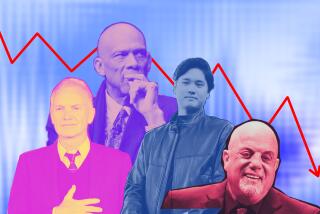Japanese Scandals Prompt a Look Closer to Home
Just a few days after American investors shook their heads in disgust at another Japanese stock scandal, we’re reminded that the pot shouldn’t be so quick to call the kettle black.
The heads of Nomura Securities and Nikko Securities resigned in Tokyo this week after disclosure that their brokerages had reimbursed favored clients for stock losses after the Japanese market crashed last year.
Totally by coincidence, the New York Stock Exchange on Wednesday sent out a routine report on 21 disciplinary actions against brokerages and individual brokers. Included were four separate censures of brokers for what’s called “sharing a loss”--where a broker makes up for part or all of what a customer lost on an investment. The practice is forbidden under NYSE rules.
Except for the monetary scale, there is little difference between the actions of the Japanese firms and the actions of the four American brokers, whose transgressions occurred as far back as the early 1980s. In fact, such censures occur routinely in the securities business. And that’s only for the cases that are discovered.
Why agree to cover a customer’s loss? For one, a broker may have incurred the loss by trading without the customer’s OK. To avoid a harsher penalty--being fired--the broker would just as soon settle up with his or her own money.
But otherwise-honest brokers may also fall into a loss-sharing trap, even when the client clearly knew the risks of an investment. If an important customer screams loud enough, a broker may unfortunately (for the rest of us) bend the rules.
One Southland broker says he’s found that doctors in particular can be notorious for trying to pressure a broker when an investment goes bad. “They’ve said to me, ‘Well, if I prescribed a treatment and it failed, I wouldn’t charge the customer,’ ” this broker said, requesting anonymity for obvious reasons.
To appease such big-money clients, a broker will sometimes agree to cut the customer’s commissions on future trades for a while, perhaps by 15% or 20%. “You want to build up their confidence in you again,” the broker said. But if a broker makes actual cash payments to an account, “then you’ve crossed the line,” the broker said.
Another veteran broker says discounting commissions just starts a vicious cycle that can lead to other problems. “You’ve already impugned the relationship” with the fight over the loss, this broker said. Once you give a discount on commissions, “the customer starts expecting it all the time.” Rather than fall into that cycle, this broker tells clients up front: “If I do a bad job, you should fire me. And if I do a good job, I expect referrals.”
Where’s the Savings? When the recession began last year, some economists said the bitter tonic would actually do us some good as a nation. It would force us to fear for our jobs, and therefore sock more money away in savings--or at least, those of us who could do it, would do it.
That was true for a while: Personal savings, measured as national disposable personal income minus personal expenditures, jumped to a $185-billion annual rate last December, or 4.6% of income. But the May figure, released Thursday, showed consumers back in their old spending habits. Personal savings fell to a $144-billion annual rate in May, or a savings rate of just 3.6%.
Economists had hoped that the national savings rate would gradually return to the 6% level in the 1990s, even as the economy returned to health. Some experts argue that the 3.6% rate is skewed by demographic changes and 401(k) savings plans, and that the true savings rate already is higher than it seems. Nonetheless, there’s general agreement that most Americans should try to visit their savings accounts more than their neighborhood restaurant for a while.
Other statistics released Thursday show that at least one group of investors still seems to be serious about building nest eggs for the long term: Mutual fund owners. New purchases of stock mutual funds totaled $7.26 billion in May, not including normal monthly purchases from reinvested dividends. Although down from April’s torrid pace of $8.84 billion, the May figure was well above the $5.79-billion figure of May, 1990.
Bond mutual funds attracted even more cash than stocks, as investors sought higher interest rates: New bond fund purchases totaled $9.13 billion, off from $9.98 billion in April but way up from $5.38 billion in May, 1990.
Americans now have $672 billion in stock and bond mutual funds, which is about 60% as much as people have invested in small CDs at banks and S&Ls; ($1.13 trillion). The difference is that the funds’ assets continue to skyrocket, while the CD total is falling rapidly.
Somebody’s saving money Despite the dismal May personal savings rate reported by the government on Thursday, more money is flowing into long-term mutual funds this year than last. Source: Investment Company Institute
More to Read
Inside the business of entertainment
The Wide Shot brings you news, analysis and insights on everything from streaming wars to production — and what it all means for the future.
You may occasionally receive promotional content from the Los Angeles Times.










